Comprehensive Analysis of Australian Income Tax Laws and Legislations
VerifiedAdded on 2022/10/15
|13
|2707
|146
Report
AI Summary
This report provides a detailed analysis of Australian taxation, focusing on income tax, capital gains tax (CGT), goods and services tax (GST), fringe benefit tax (FBT), withholding tax, self-assessment tax, and anti-avoidance rules. It examines income tax rates for residents and non-residents, and includes case studies on Emma's capital gain tax and City Sky Company's GST to demonstrate real-world application of these concepts. The report also covers key tax legislations and principles like efficiency, equity, neutrality, and simplicity. It explores the application of GST and CGT in specific scenarios, and provides a comprehensive overview of the Australian tax system. The report aims to equip students with a thorough understanding of tax concepts, deductions, and their practical implications.
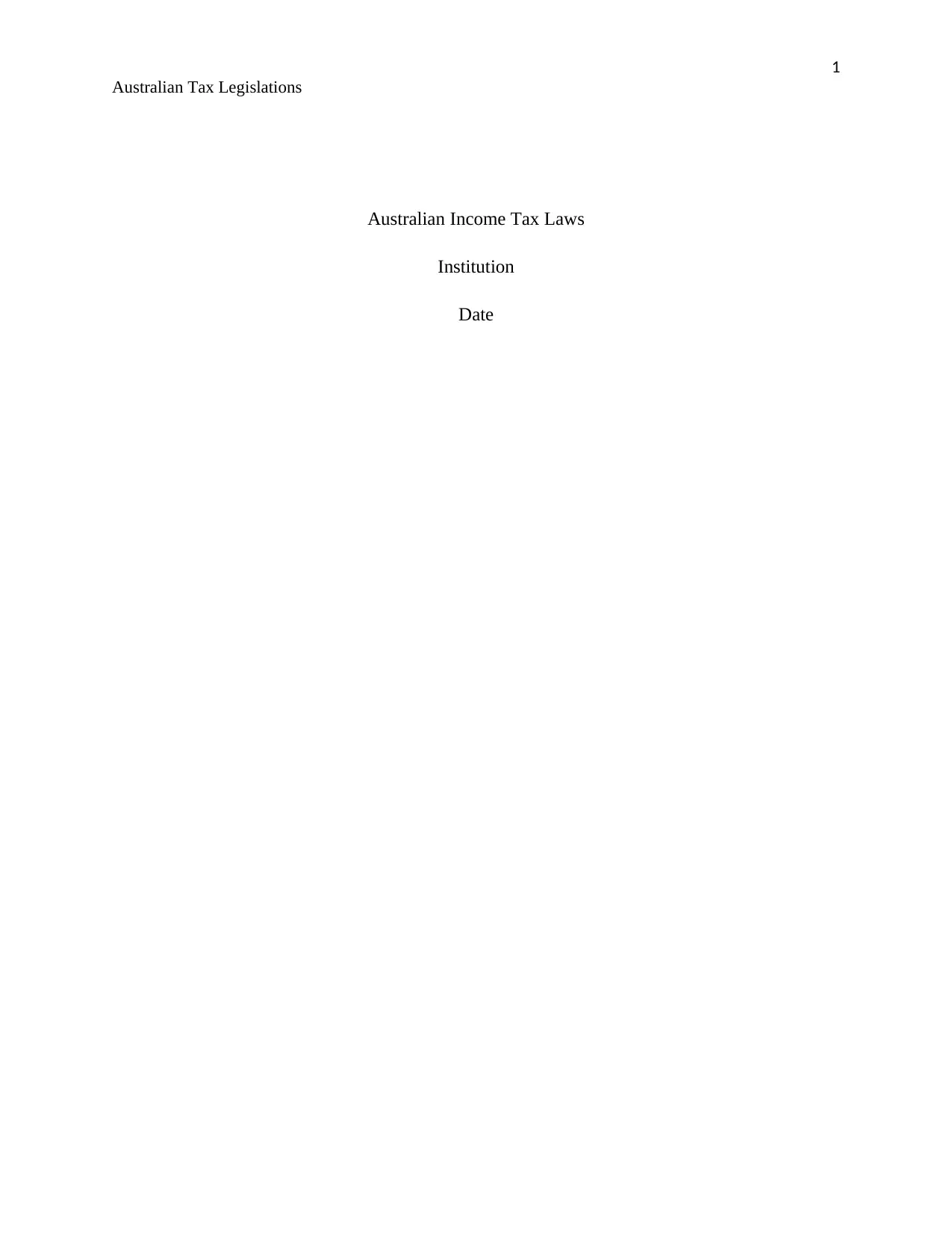
1
Australian Tax Legislations
Australian Income Tax Laws
Institution
Date
Australian Tax Legislations
Australian Income Tax Laws
Institution
Date
Paraphrase This Document
Need a fresh take? Get an instant paraphrase of this document with our AI Paraphraser

2
Australian Tax Legislations
Executive summary
The aim of this report is to analyze various aspects of taxation concepts such as the income tax
and the rules applied on the same and how they can be applied in real life. The report also
intends to equip the student with the understanding and knowledge on various deductions
concerning income ax both in Australia and Diaspora.
A case study on Emma’s capital gain tax and city sky company‘s goods and service tax
demonstrate best approaches to GST and CGT issues. Finally, the report contain s the taxation
principles which illustrates what a tax system should demonstrate.
Australian Tax Legislations
Executive summary
The aim of this report is to analyze various aspects of taxation concepts such as the income tax
and the rules applied on the same and how they can be applied in real life. The report also
intends to equip the student with the understanding and knowledge on various deductions
concerning income ax both in Australia and Diaspora.
A case study on Emma’s capital gain tax and city sky company‘s goods and service tax
demonstrate best approaches to GST and CGT issues. Finally, the report contain s the taxation
principles which illustrates what a tax system should demonstrate.
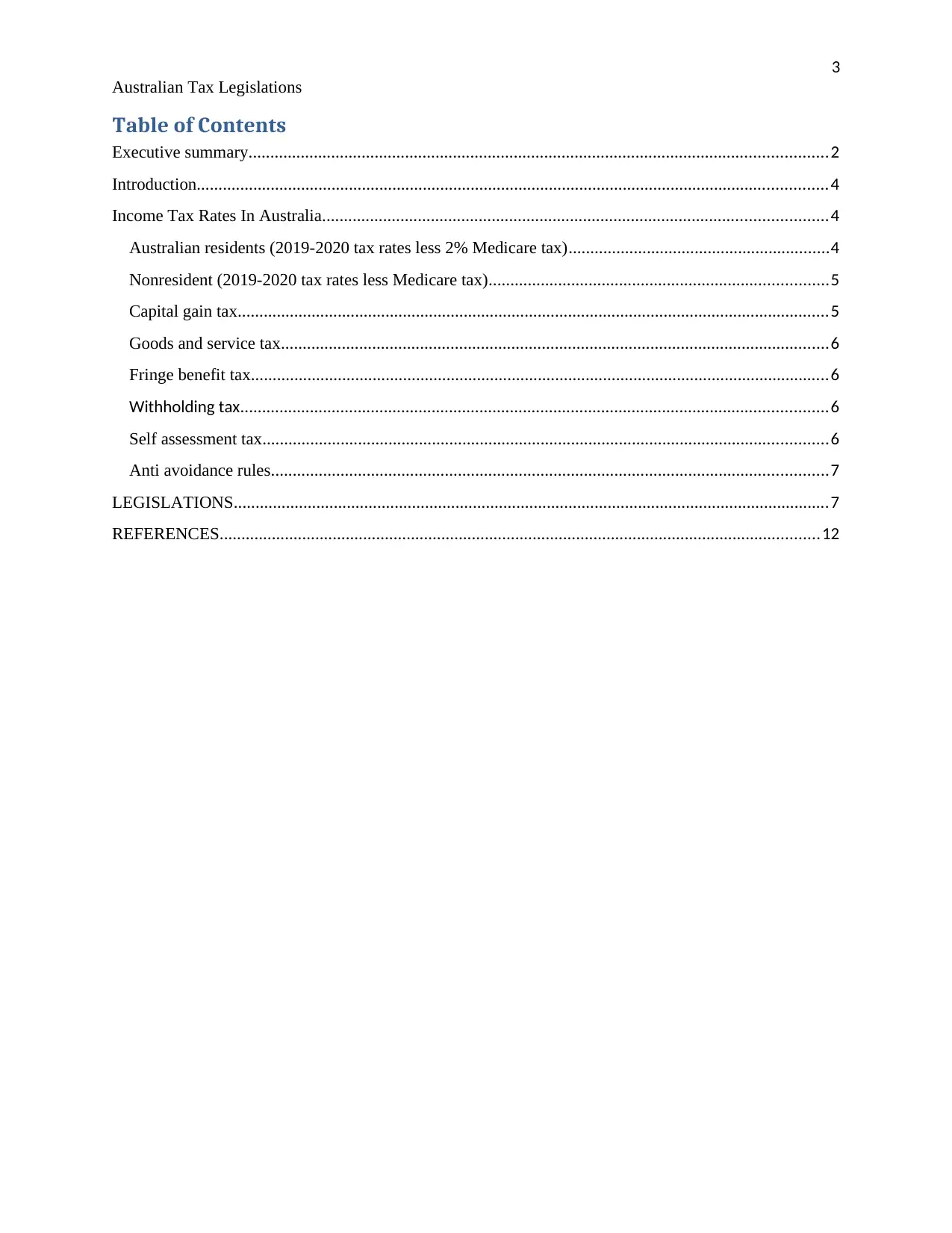
3
Australian Tax Legislations
Table of Contents
Executive summary.....................................................................................................................................2
Introduction.................................................................................................................................................4
Income Tax Rates In Australia....................................................................................................................4
Australian residents (2019-2020 tax rates less 2% Medicare tax)............................................................4
Nonresident (2019-2020 tax rates less Medicare tax)..............................................................................5
Capital gain tax........................................................................................................................................5
Goods and service tax..............................................................................................................................6
Fringe benefit tax.....................................................................................................................................6
Withholding tax.......................................................................................................................................6
Self assessment tax..................................................................................................................................6
Anti avoidance rules................................................................................................................................7
LEGISLATIONS.........................................................................................................................................7
REFERENCES..........................................................................................................................................12
Australian Tax Legislations
Table of Contents
Executive summary.....................................................................................................................................2
Introduction.................................................................................................................................................4
Income Tax Rates In Australia....................................................................................................................4
Australian residents (2019-2020 tax rates less 2% Medicare tax)............................................................4
Nonresident (2019-2020 tax rates less Medicare tax)..............................................................................5
Capital gain tax........................................................................................................................................5
Goods and service tax..............................................................................................................................6
Fringe benefit tax.....................................................................................................................................6
Withholding tax.......................................................................................................................................6
Self assessment tax..................................................................................................................................6
Anti avoidance rules................................................................................................................................7
LEGISLATIONS.........................................................................................................................................7
REFERENCES..........................................................................................................................................12
⊘ This is a preview!⊘
Do you want full access?
Subscribe today to unlock all pages.

Trusted by 1+ million students worldwide
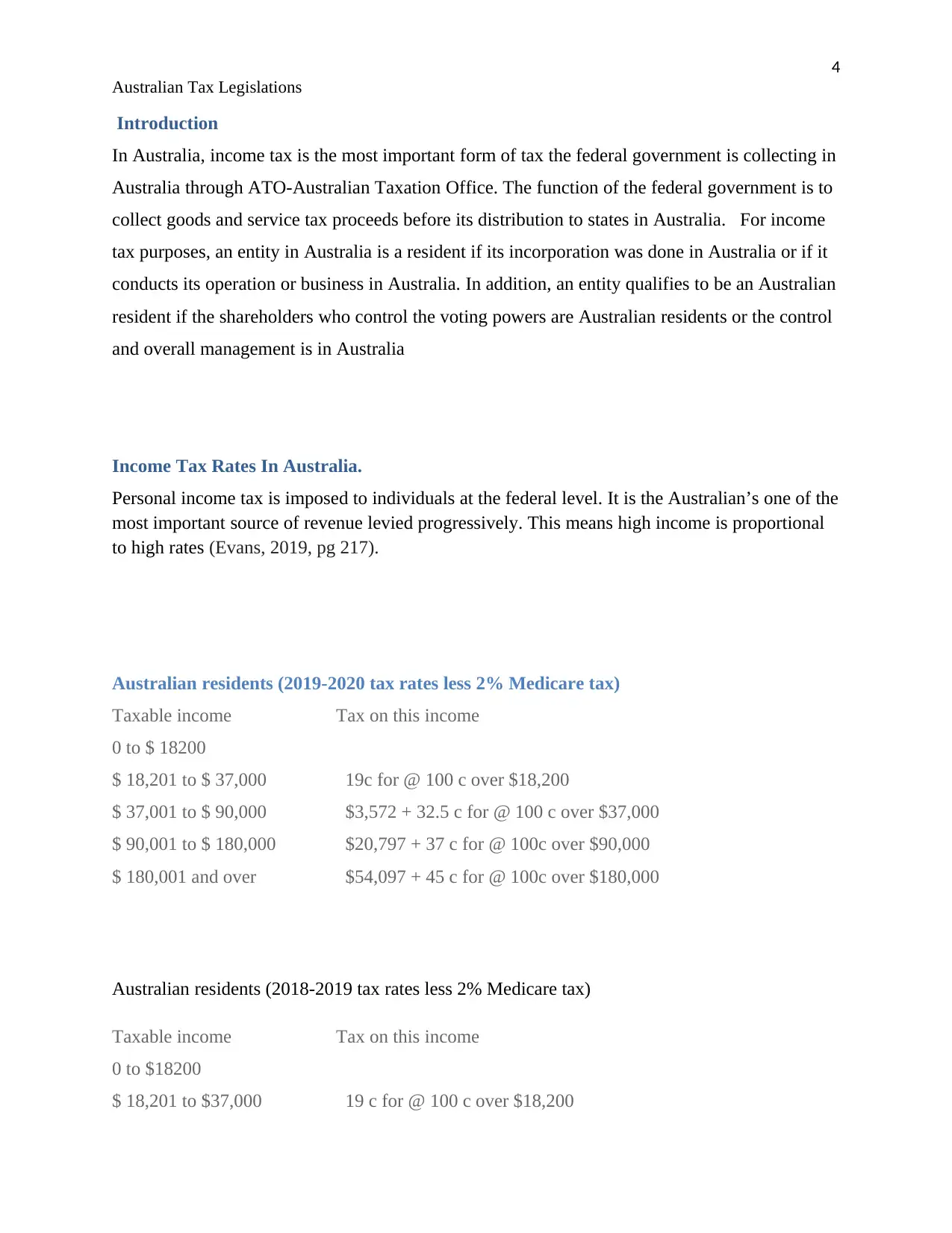
4
Australian Tax Legislations
Introduction
In Australia, income tax is the most important form of tax the federal government is collecting in
Australia through ATO-Australian Taxation Office. The function of the federal government is to
collect goods and service tax proceeds before its distribution to states in Australia. For income
tax purposes, an entity in Australia is a resident if its incorporation was done in Australia or if it
conducts its operation or business in Australia. In addition, an entity qualifies to be an Australian
resident if the shareholders who control the voting powers are Australian residents or the control
and overall management is in Australia
Income Tax Rates In Australia.
Personal income tax is imposed to individuals at the federal level. It is the Australian’s one of the
most important source of revenue levied progressively. This means high income is proportional
to high rates (Evans, 2019, pg 217).
Australian residents (2019-2020 tax rates less 2% Medicare tax)
Taxable income Tax on this income
0 to $ 18200
$ 18,201 to $ 37,000 19c for @ 100 c over $18,200
$ 37,001 to $ 90,000 $3,572 + 32.5 c for @ 100 c over $37,000
$ 90,001 to $ 180,000 $20,797 + 37 c for @ 100c over $90,000
$ 180,001 and over $54,097 + 45 c for @ 100c over $180,000
Australian residents (2018-2019 tax rates less 2% Medicare tax)
Taxable income Tax on this income
0 to $18200
$ 18,201 to $37,000 19 c for @ 100 c over $18,200
Australian Tax Legislations
Introduction
In Australia, income tax is the most important form of tax the federal government is collecting in
Australia through ATO-Australian Taxation Office. The function of the federal government is to
collect goods and service tax proceeds before its distribution to states in Australia. For income
tax purposes, an entity in Australia is a resident if its incorporation was done in Australia or if it
conducts its operation or business in Australia. In addition, an entity qualifies to be an Australian
resident if the shareholders who control the voting powers are Australian residents or the control
and overall management is in Australia
Income Tax Rates In Australia.
Personal income tax is imposed to individuals at the federal level. It is the Australian’s one of the
most important source of revenue levied progressively. This means high income is proportional
to high rates (Evans, 2019, pg 217).
Australian residents (2019-2020 tax rates less 2% Medicare tax)
Taxable income Tax on this income
0 to $ 18200
$ 18,201 to $ 37,000 19c for @ 100 c over $18,200
$ 37,001 to $ 90,000 $3,572 + 32.5 c for @ 100 c over $37,000
$ 90,001 to $ 180,000 $20,797 + 37 c for @ 100c over $90,000
$ 180,001 and over $54,097 + 45 c for @ 100c over $180,000
Australian residents (2018-2019 tax rates less 2% Medicare tax)
Taxable income Tax on this income
0 to $18200
$ 18,201 to $37,000 19 c for @ 100 c over $18,200
Paraphrase This Document
Need a fresh take? Get an instant paraphrase of this document with our AI Paraphraser

5
Australian Tax Legislations
$ 37,001 to $90,000 $ 3,572 + 32.5 c for @ 100 c over $37,000
$ 90,001 to $180,000 $ 20,797 + 37 c for @ 100c over $90,000
$ 180,001 & over $ 54,097 + 45 c for @ 100c over $180,000
Nonresident (2019-2020 tax rates less Medicare tax)
Taxable income Tax on this income
0 to $ 90,000 32.5 c for @ 100 c
$ 90,001 to $ 180,000 $ 29,250 + 37 c for @ 100c over $ 90,000
$ 180,001 & over $ 62,550 + 45 c for @ 100 c over $ 180,000
Nonresident (2018-2019 tax rates Medicare tax)
Taxable income Tax on this income
0 to $ 90,000 32.5 c for @ 100 c
$ 90,001 to $ 180,000 $ 29,250 + 37 c for @ 100c over $ 90,000
$ 180,001 & over $ 62,550 + 45 c for @ 100 c over $ 180,000
Capital gain tax
The Australian taxation system outlines CGT as the charge imposed on earnings gained from
sale of assets. Exemptions on this excise duty however exist on health provisions and personal
homes. Australian residents are liable to 30% capital gain tax or 27.5% on global net earnings.
Assets that are exempted from capital gain tax include personal home, motor vehicle and those
meant for personal use (Chan, 2019, pg 312).
A 50% discount on tax is allowed to Australian resident if the asset is held more than year.for
non residents, tax payers are reinstated to their positions on capital losses using the capital
earnings. The amendment of capital gain tax rule legalizes the payment of taxes on capital gains
and incomes. Both the Australian residents and foreigners are subject GST and income tax. A
Australian Tax Legislations
$ 37,001 to $90,000 $ 3,572 + 32.5 c for @ 100 c over $37,000
$ 90,001 to $180,000 $ 20,797 + 37 c for @ 100c over $90,000
$ 180,001 & over $ 54,097 + 45 c for @ 100c over $180,000
Nonresident (2019-2020 tax rates less Medicare tax)
Taxable income Tax on this income
0 to $ 90,000 32.5 c for @ 100 c
$ 90,001 to $ 180,000 $ 29,250 + 37 c for @ 100c over $ 90,000
$ 180,001 & over $ 62,550 + 45 c for @ 100 c over $ 180,000
Nonresident (2018-2019 tax rates Medicare tax)
Taxable income Tax on this income
0 to $ 90,000 32.5 c for @ 100 c
$ 90,001 to $ 180,000 $ 29,250 + 37 c for @ 100c over $ 90,000
$ 180,001 & over $ 62,550 + 45 c for @ 100 c over $ 180,000
Capital gain tax
The Australian taxation system outlines CGT as the charge imposed on earnings gained from
sale of assets. Exemptions on this excise duty however exist on health provisions and personal
homes. Australian residents are liable to 30% capital gain tax or 27.5% on global net earnings.
Assets that are exempted from capital gain tax include personal home, motor vehicle and those
meant for personal use (Chan, 2019, pg 312).
A 50% discount on tax is allowed to Australian resident if the asset is held more than year.for
non residents, tax payers are reinstated to their positions on capital losses using the capital
earnings. The amendment of capital gain tax rule legalizes the payment of taxes on capital gains
and incomes. Both the Australian residents and foreigners are subject GST and income tax. A
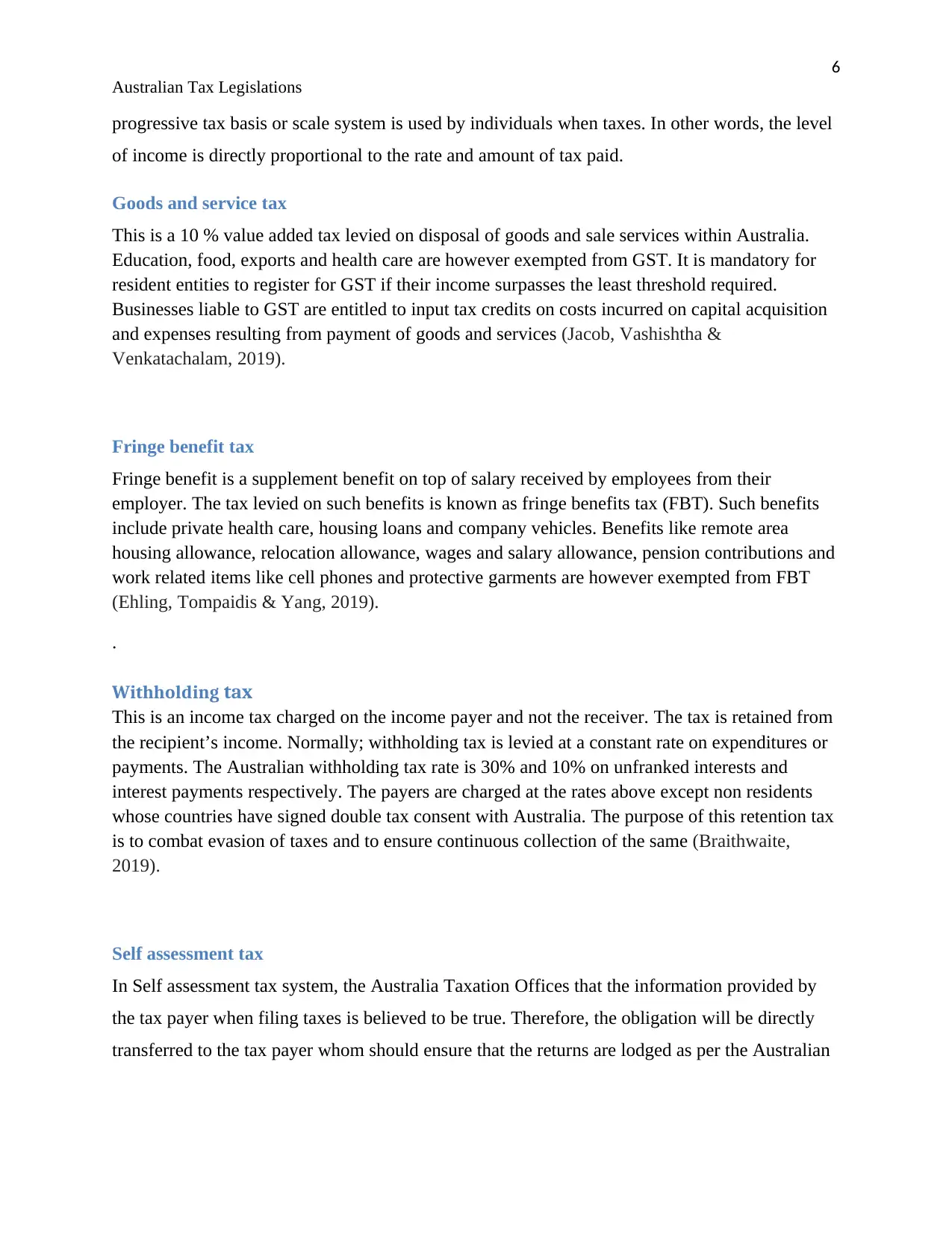
6
Australian Tax Legislations
progressive tax basis or scale system is used by individuals when taxes. In other words, the level
of income is directly proportional to the rate and amount of tax paid.
Goods and service tax
This is a 10 % value added tax levied on disposal of goods and sale services within Australia.
Education, food, exports and health care are however exempted from GST. It is mandatory for
resident entities to register for GST if their income surpasses the least threshold required.
Businesses liable to GST are entitled to input tax credits on costs incurred on capital acquisition
and expenses resulting from payment of goods and services (Jacob, Vashishtha &
Venkatachalam, 2019).
Fringe benefit tax
Fringe benefit is a supplement benefit on top of salary received by employees from their
employer. The tax levied on such benefits is known as fringe benefits tax (FBT). Such benefits
include private health care, housing loans and company vehicles. Benefits like remote area
housing allowance, relocation allowance, wages and salary allowance, pension contributions and
work related items like cell phones and protective garments are however exempted from FBT
(Ehling, Tompaidis & Yang, 2019).
.
Withholding tax
This is an income tax charged on the income payer and not the receiver. The tax is retained from
the recipient’s income. Normally; withholding tax is levied at a constant rate on expenditures or
payments. The Australian withholding tax rate is 30% and 10% on unfranked interests and
interest payments respectively. The payers are charged at the rates above except non residents
whose countries have signed double tax consent with Australia. The purpose of this retention tax
is to combat evasion of taxes and to ensure continuous collection of the same (Braithwaite,
2019).
Self assessment tax
In Self assessment tax system, the Australia Taxation Offices that the information provided by
the tax payer when filing taxes is believed to be true. Therefore, the obligation will be directly
transferred to the tax payer whom should ensure that the returns are lodged as per the Australian
Australian Tax Legislations
progressive tax basis or scale system is used by individuals when taxes. In other words, the level
of income is directly proportional to the rate and amount of tax paid.
Goods and service tax
This is a 10 % value added tax levied on disposal of goods and sale services within Australia.
Education, food, exports and health care are however exempted from GST. It is mandatory for
resident entities to register for GST if their income surpasses the least threshold required.
Businesses liable to GST are entitled to input tax credits on costs incurred on capital acquisition
and expenses resulting from payment of goods and services (Jacob, Vashishtha &
Venkatachalam, 2019).
Fringe benefit tax
Fringe benefit is a supplement benefit on top of salary received by employees from their
employer. The tax levied on such benefits is known as fringe benefits tax (FBT). Such benefits
include private health care, housing loans and company vehicles. Benefits like remote area
housing allowance, relocation allowance, wages and salary allowance, pension contributions and
work related items like cell phones and protective garments are however exempted from FBT
(Ehling, Tompaidis & Yang, 2019).
.
Withholding tax
This is an income tax charged on the income payer and not the receiver. The tax is retained from
the recipient’s income. Normally; withholding tax is levied at a constant rate on expenditures or
payments. The Australian withholding tax rate is 30% and 10% on unfranked interests and
interest payments respectively. The payers are charged at the rates above except non residents
whose countries have signed double tax consent with Australia. The purpose of this retention tax
is to combat evasion of taxes and to ensure continuous collection of the same (Braithwaite,
2019).
Self assessment tax
In Self assessment tax system, the Australia Taxation Offices that the information provided by
the tax payer when filing taxes is believed to be true. Therefore, the obligation will be directly
transferred to the tax payer whom should ensure that the returns are lodged as per the Australian
⊘ This is a preview!⊘
Do you want full access?
Subscribe today to unlock all pages.

Trusted by 1+ million students worldwide
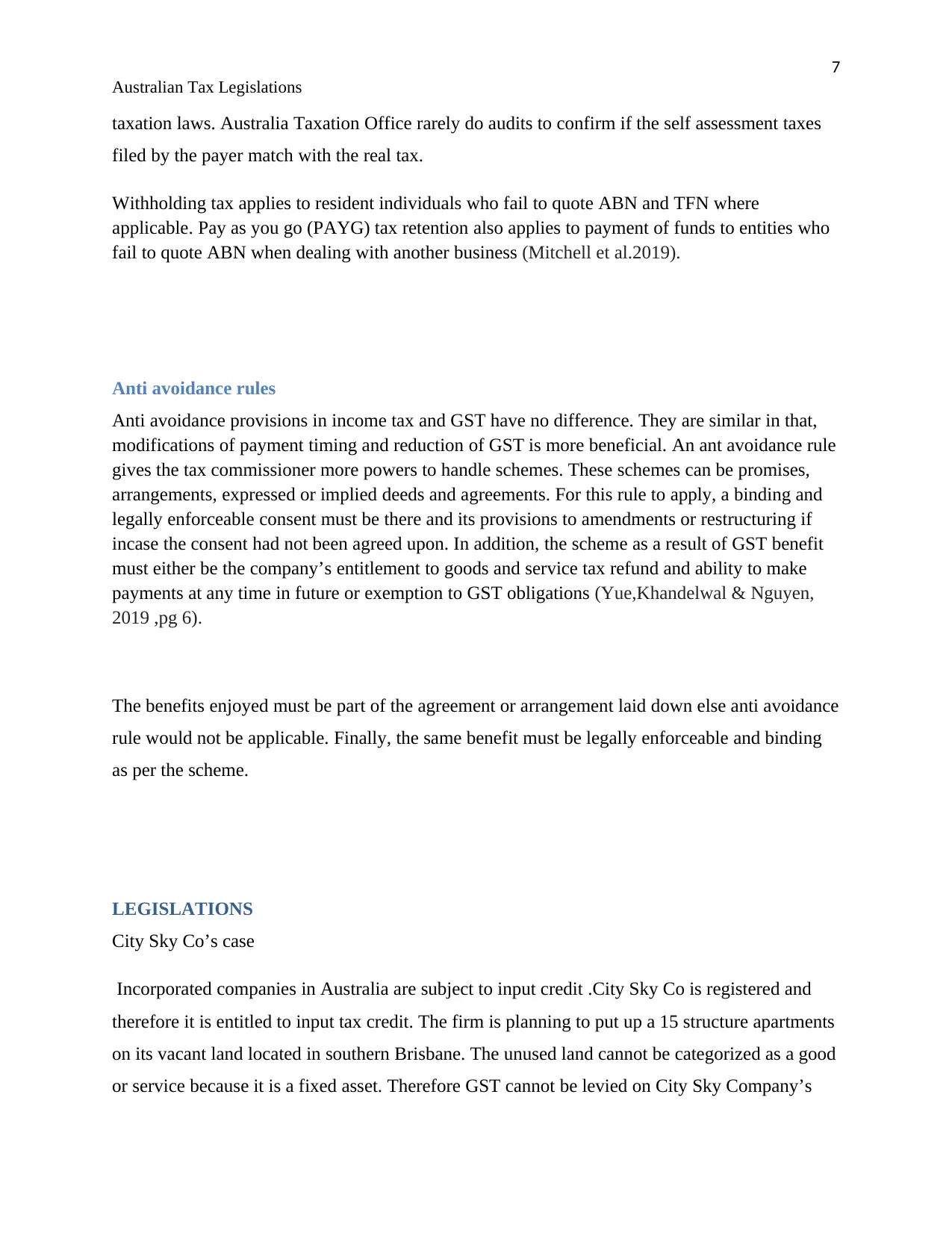
7
Australian Tax Legislations
taxation laws. Australia Taxation Office rarely do audits to confirm if the self assessment taxes
filed by the payer match with the real tax.
Withholding tax applies to resident individuals who fail to quote ABN and TFN where
applicable. Pay as you go (PAYG) tax retention also applies to payment of funds to entities who
fail to quote ABN when dealing with another business (Mitchell et al.2019).
Anti avoidance rules
Anti avoidance provisions in income tax and GST have no difference. They are similar in that,
modifications of payment timing and reduction of GST is more beneficial. An ant avoidance rule
gives the tax commissioner more powers to handle schemes. These schemes can be promises,
arrangements, expressed or implied deeds and agreements. For this rule to apply, a binding and
legally enforceable consent must be there and its provisions to amendments or restructuring if
incase the consent had not been agreed upon. In addition, the scheme as a result of GST benefit
must either be the company’s entitlement to goods and service tax refund and ability to make
payments at any time in future or exemption to GST obligations (Yue,Khandelwal & Nguyen,
2019 ,pg 6).
The benefits enjoyed must be part of the agreement or arrangement laid down else anti avoidance
rule would not be applicable. Finally, the same benefit must be legally enforceable and binding
as per the scheme.
LEGISLATIONS
City Sky Co’s case
Incorporated companies in Australia are subject to input credit .City Sky Co is registered and
therefore it is entitled to input tax credit. The firm is planning to put up a 15 structure apartments
on its vacant land located in southern Brisbane. The unused land cannot be categorized as a good
or service because it is a fixed asset. Therefore GST cannot be levied on City Sky Company’s
Australian Tax Legislations
taxation laws. Australia Taxation Office rarely do audits to confirm if the self assessment taxes
filed by the payer match with the real tax.
Withholding tax applies to resident individuals who fail to quote ABN and TFN where
applicable. Pay as you go (PAYG) tax retention also applies to payment of funds to entities who
fail to quote ABN when dealing with another business (Mitchell et al.2019).
Anti avoidance rules
Anti avoidance provisions in income tax and GST have no difference. They are similar in that,
modifications of payment timing and reduction of GST is more beneficial. An ant avoidance rule
gives the tax commissioner more powers to handle schemes. These schemes can be promises,
arrangements, expressed or implied deeds and agreements. For this rule to apply, a binding and
legally enforceable consent must be there and its provisions to amendments or restructuring if
incase the consent had not been agreed upon. In addition, the scheme as a result of GST benefit
must either be the company’s entitlement to goods and service tax refund and ability to make
payments at any time in future or exemption to GST obligations (Yue,Khandelwal & Nguyen,
2019 ,pg 6).
The benefits enjoyed must be part of the agreement or arrangement laid down else anti avoidance
rule would not be applicable. Finally, the same benefit must be legally enforceable and binding
as per the scheme.
LEGISLATIONS
City Sky Co’s case
Incorporated companies in Australia are subject to input credit .City Sky Co is registered and
therefore it is entitled to input tax credit. The firm is planning to put up a 15 structure apartments
on its vacant land located in southern Brisbane. The unused land cannot be categorized as a good
or service because it is a fixed asset. Therefore GST cannot be levied on City Sky Company’s
Paraphrase This Document
Need a fresh take? Get an instant paraphrase of this document with our AI Paraphraser
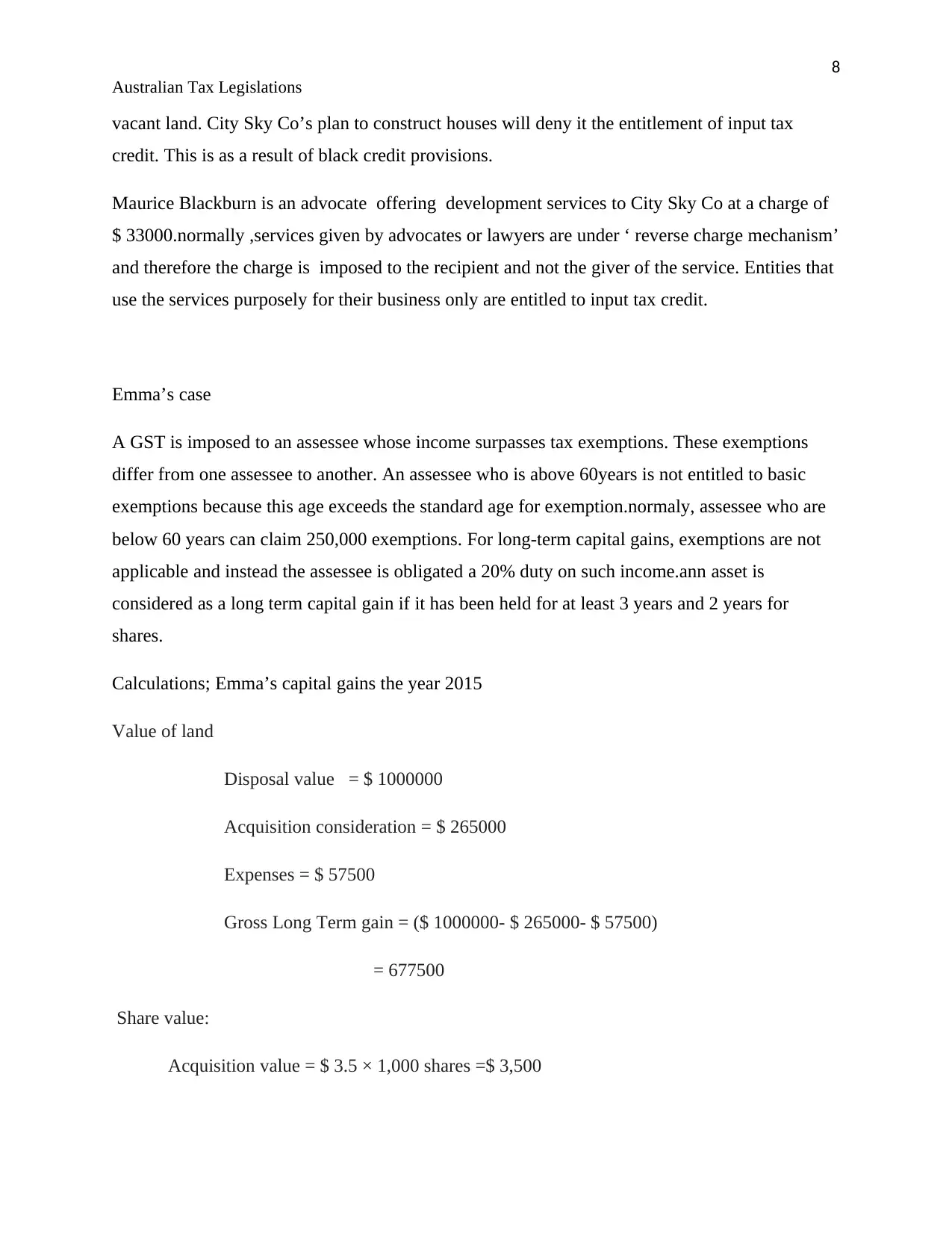
8
Australian Tax Legislations
vacant land. City Sky Co’s plan to construct houses will deny it the entitlement of input tax
credit. This is as a result of black credit provisions.
Maurice Blackburn is an advocate offering development services to City Sky Co at a charge of
$ 33000.normally ,services given by advocates or lawyers are under ‘ reverse charge mechanism’
and therefore the charge is imposed to the recipient and not the giver of the service. Entities that
use the services purposely for their business only are entitled to input tax credit.
Emma’s case
A GST is imposed to an assessee whose income surpasses tax exemptions. These exemptions
differ from one assessee to another. An assessee who is above 60years is not entitled to basic
exemptions because this age exceeds the standard age for exemption.normaly, assessee who are
below 60 years can claim 250,000 exemptions. For long-term capital gains, exemptions are not
applicable and instead the assessee is obligated a 20% duty on such income.ann asset is
considered as a long term capital gain if it has been held for at least 3 years and 2 years for
shares.
Calculations; Emma’s capital gains the year 2015
Value of land
Disposal value = $ 1000000
Acquisition consideration = $ 265000
Expenses = $ 57500
Gross Long Term gain = ($ 1000000- $ 265000- $ 57500)
= 677500
Share value:
Acquisition value = $ 3.5 × 1,000 shares =$ 3,500
Australian Tax Legislations
vacant land. City Sky Co’s plan to construct houses will deny it the entitlement of input tax
credit. This is as a result of black credit provisions.
Maurice Blackburn is an advocate offering development services to City Sky Co at a charge of
$ 33000.normally ,services given by advocates or lawyers are under ‘ reverse charge mechanism’
and therefore the charge is imposed to the recipient and not the giver of the service. Entities that
use the services purposely for their business only are entitled to input tax credit.
Emma’s case
A GST is imposed to an assessee whose income surpasses tax exemptions. These exemptions
differ from one assessee to another. An assessee who is above 60years is not entitled to basic
exemptions because this age exceeds the standard age for exemption.normaly, assessee who are
below 60 years can claim 250,000 exemptions. For long-term capital gains, exemptions are not
applicable and instead the assessee is obligated a 20% duty on such income.ann asset is
considered as a long term capital gain if it has been held for at least 3 years and 2 years for
shares.
Calculations; Emma’s capital gains the year 2015
Value of land
Disposal value = $ 1000000
Acquisition consideration = $ 265000
Expenses = $ 57500
Gross Long Term gain = ($ 1000000- $ 265000- $ 57500)
= 677500
Share value:
Acquisition value = $ 3.5 × 1,000 shares =$ 3,500
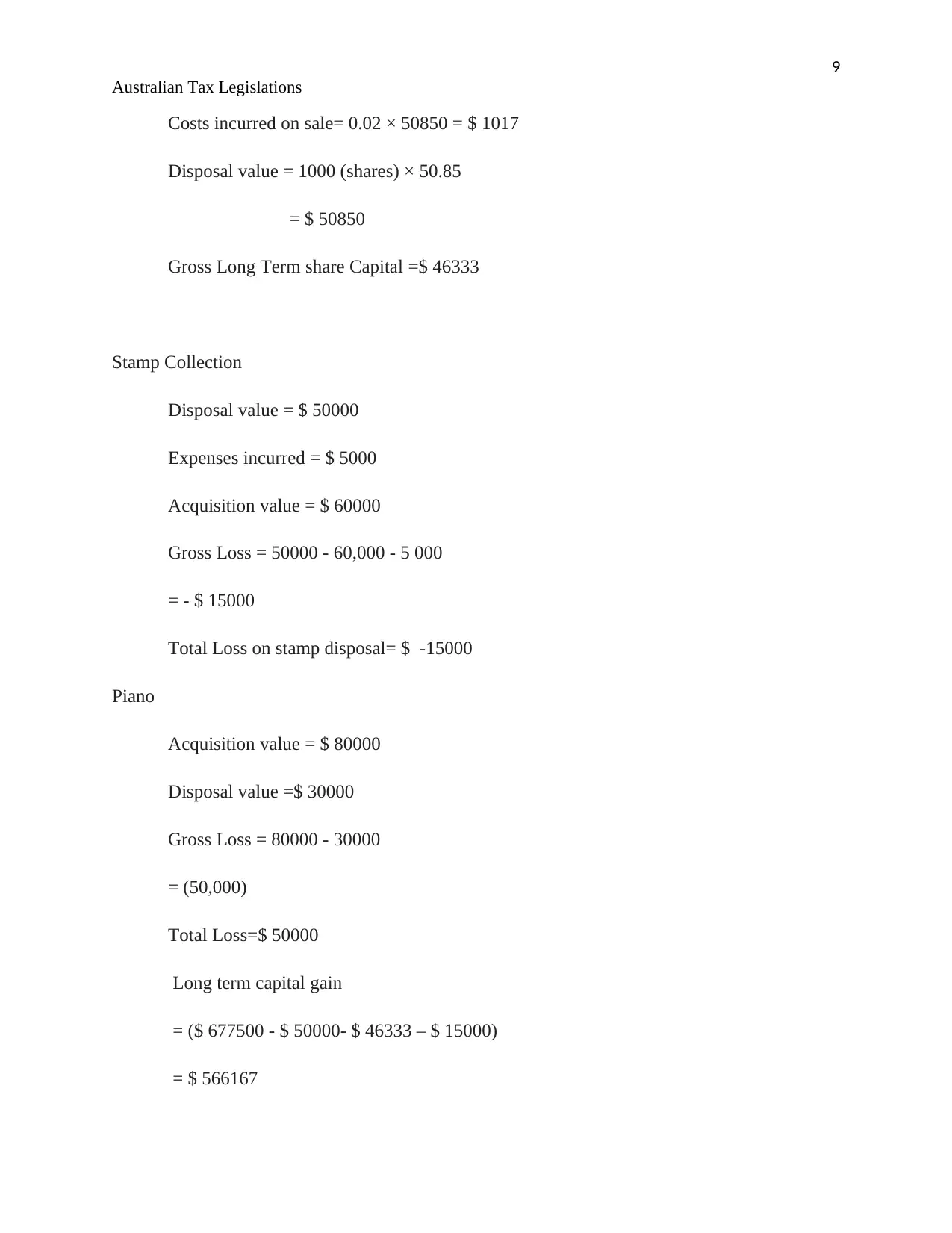
9
Australian Tax Legislations
Costs incurred on sale= 0.02 × 50850 = $ 1017
Disposal value = 1000 (shares) × 50.85
= $ 50850
Gross Long Term share Capital =$ 46333
Stamp Collection
Disposal value = $ 50000
Expenses incurred = $ 5000
Acquisition value = $ 60000
Gross Loss = 50000 - 60,000 - 5 000
= - $ 15000
Total Loss on stamp disposal= $ -15000
Piano
Acquisition value = $ 80000
Disposal value =$ 30000
Gross Loss = 80000 - 30000
= (50,000)
Total Loss=$ 50000
Long term capital gain
= ($ 677500 - $ 50000- $ 46333 – $ 15000)
= $ 566167
Australian Tax Legislations
Costs incurred on sale= 0.02 × 50850 = $ 1017
Disposal value = 1000 (shares) × 50.85
= $ 50850
Gross Long Term share Capital =$ 46333
Stamp Collection
Disposal value = $ 50000
Expenses incurred = $ 5000
Acquisition value = $ 60000
Gross Loss = 50000 - 60,000 - 5 000
= - $ 15000
Total Loss on stamp disposal= $ -15000
Piano
Acquisition value = $ 80000
Disposal value =$ 30000
Gross Loss = 80000 - 30000
= (50,000)
Total Loss=$ 50000
Long term capital gain
= ($ 677500 - $ 50000- $ 46333 – $ 15000)
= $ 566167
⊘ This is a preview!⊘
Do you want full access?
Subscribe today to unlock all pages.

Trusted by 1+ million students worldwide

10
Australian Tax Legislations
Tax charged on long term gain in 2015
= 0.02× 566167
= $ 113233.
The assessee can be entitled to set off loss on long-term capital gains with earnings gained from
long term capital. For individuals, tax returns are filed before every 31st of July on yearly basis
according to the 1961 income tax act of Australia (Shome, 2019, pg 355).
.
TAX PRINCIPLES IN AUSTRALIA
A good tax system should demonstrate basic values like efficiency, equity, neutrality and
simplicity.
Neutrality is one of the significant fundamental elements essential in a tax system. Payers should
not feel the effect on their choice to pay the tax imposed on them. The principle of certainty
states that the tax payers should be made aware of their tax responsibility before they make any
plans to meet the provisions (Storm & Coetzee, 2018, pg 151).
A good tax system should also be clear and easily understood by the tax payers and the
population responsible for the tax burden. Payers should understand their tax responsibility.
The principle of equity is concerned with the distribution of tax burden to the population.
Allocation should be fair to every tax payer. The obligation can be done vertically, horizontally
and on benefit principle. .For horizontal distribution, assessee are taxed based on their equal
level of income. It perceives that equally paid individuals are supposed to be taxed equally;
however this kind of principle is difficult to put into practice .Vertical equity on the other hand,
tax payers are charged based on their income levels. The able payers are supposed to pay
maximum taxes according to this principle. On broader perspective, vertical tax principle implies
that a fair tax system is where taxes are paid to government based on one’s financial ability (Tran
& Zakariyya, 2019).
Australian Tax Legislations
Tax charged on long term gain in 2015
= 0.02× 566167
= $ 113233.
The assessee can be entitled to set off loss on long-term capital gains with earnings gained from
long term capital. For individuals, tax returns are filed before every 31st of July on yearly basis
according to the 1961 income tax act of Australia (Shome, 2019, pg 355).
.
TAX PRINCIPLES IN AUSTRALIA
A good tax system should demonstrate basic values like efficiency, equity, neutrality and
simplicity.
Neutrality is one of the significant fundamental elements essential in a tax system. Payers should
not feel the effect on their choice to pay the tax imposed on them. The principle of certainty
states that the tax payers should be made aware of their tax responsibility before they make any
plans to meet the provisions (Storm & Coetzee, 2018, pg 151).
A good tax system should also be clear and easily understood by the tax payers and the
population responsible for the tax burden. Payers should understand their tax responsibility.
The principle of equity is concerned with the distribution of tax burden to the population.
Allocation should be fair to every tax payer. The obligation can be done vertically, horizontally
and on benefit principle. .For horizontal distribution, assessee are taxed based on their equal
level of income. It perceives that equally paid individuals are supposed to be taxed equally;
however this kind of principle is difficult to put into practice .Vertical equity on the other hand,
tax payers are charged based on their income levels. The able payers are supposed to pay
maximum taxes according to this principle. On broader perspective, vertical tax principle implies
that a fair tax system is where taxes are paid to government based on one’s financial ability (Tran
& Zakariyya, 2019).
Paraphrase This Document
Need a fresh take? Get an instant paraphrase of this document with our AI Paraphraser
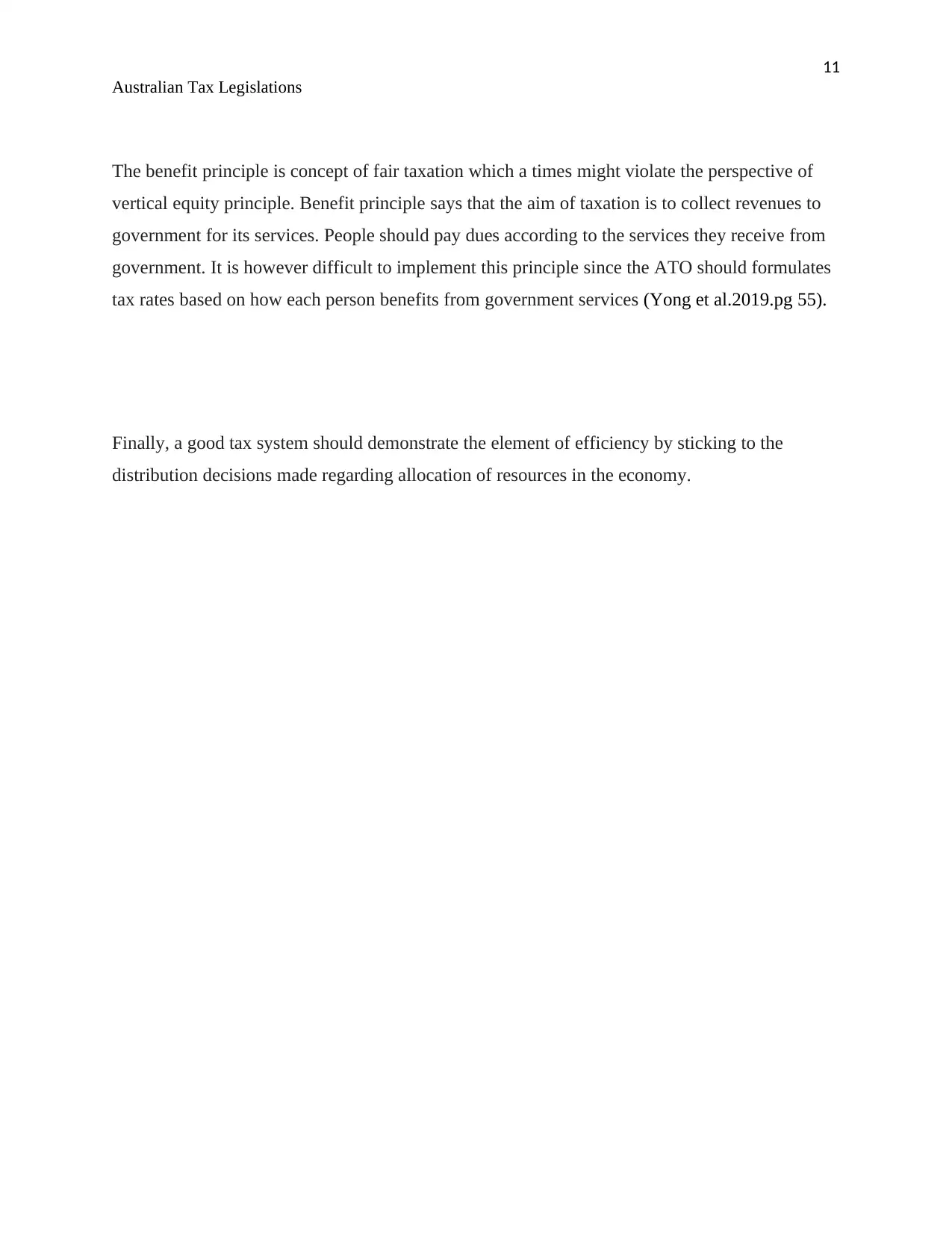
11
Australian Tax Legislations
The benefit principle is concept of fair taxation which a times might violate the perspective of
vertical equity principle. Benefit principle says that the aim of taxation is to collect revenues to
government for its services. People should pay dues according to the services they receive from
government. It is however difficult to implement this principle since the ATO should formulates
tax rates based on how each person benefits from government services (Yong et al.2019.pg 55).
Finally, a good tax system should demonstrate the element of efficiency by sticking to the
distribution decisions made regarding allocation of resources in the economy.
Australian Tax Legislations
The benefit principle is concept of fair taxation which a times might violate the perspective of
vertical equity principle. Benefit principle says that the aim of taxation is to collect revenues to
government for its services. People should pay dues according to the services they receive from
government. It is however difficult to implement this principle since the ATO should formulates
tax rates based on how each person benefits from government services (Yong et al.2019.pg 55).
Finally, a good tax system should demonstrate the element of efficiency by sticking to the
distribution decisions made regarding allocation of resources in the economy.
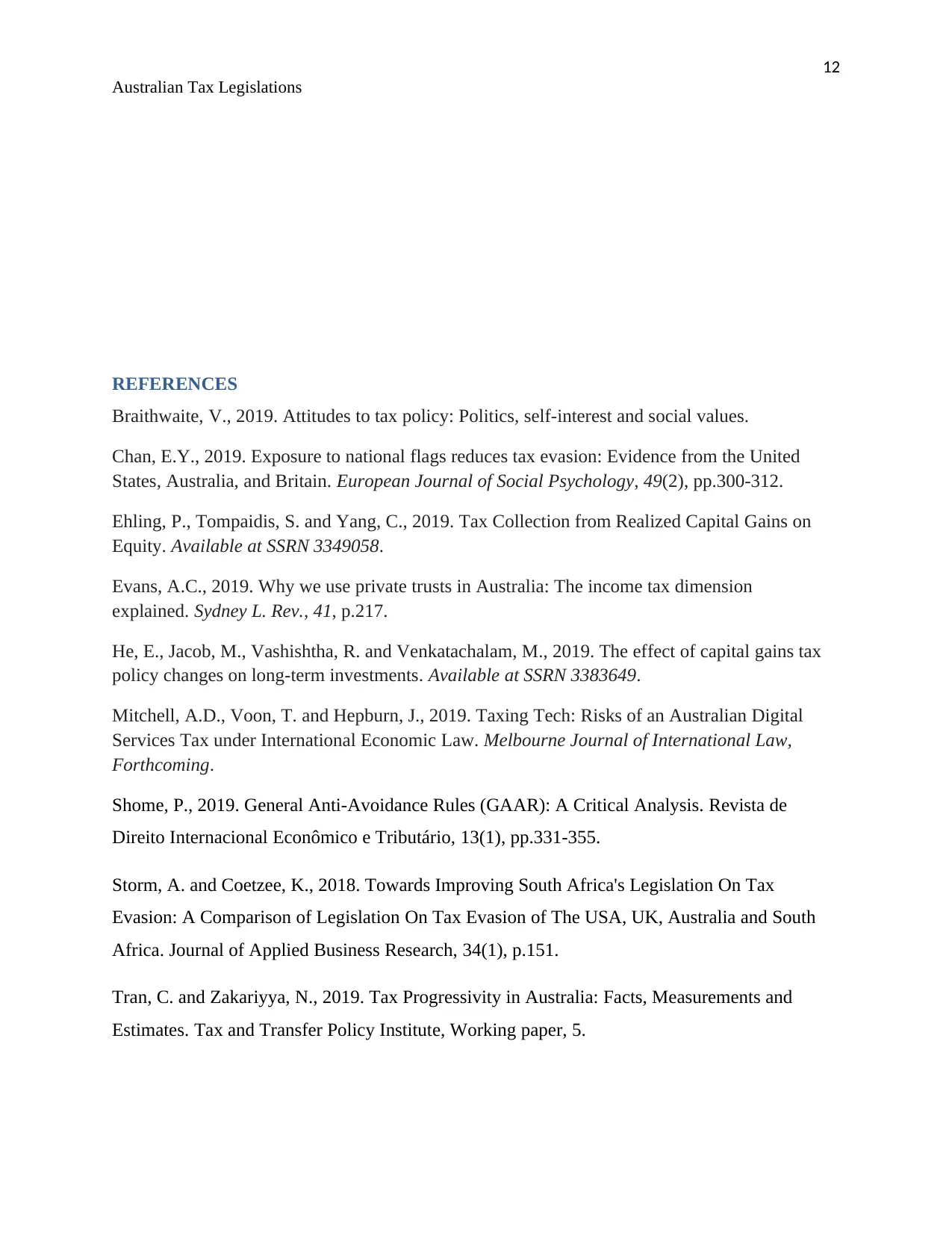
12
Australian Tax Legislations
REFERENCES
Braithwaite, V., 2019. Attitudes to tax policy: Politics, self-interest and social values.
Chan, E.Y., 2019. Exposure to national flags reduces tax evasion: Evidence from the United
States, Australia, and Britain. European Journal of Social Psychology, 49(2), pp.300-312.
Ehling, P., Tompaidis, S. and Yang, C., 2019. Tax Collection from Realized Capital Gains on
Equity. Available at SSRN 3349058.
Evans, A.C., 2019. Why we use private trusts in Australia: The income tax dimension
explained. Sydney L. Rev., 41, p.217.
He, E., Jacob, M., Vashishtha, R. and Venkatachalam, M., 2019. The effect of capital gains tax
policy changes on long-term investments. Available at SSRN 3383649.
Mitchell, A.D., Voon, T. and Hepburn, J., 2019. Taxing Tech: Risks of an Australian Digital
Services Tax under International Economic Law. Melbourne Journal of International Law,
Forthcoming.
Shome, P., 2019. General Anti-Avoidance Rules (GAAR): A Critical Analysis. Revista de
Direito Internacional Econômico e Tributário, 13(1), pp.331-355.
Storm, A. and Coetzee, K., 2018. Towards Improving South Africa's Legislation On Tax
Evasion: A Comparison of Legislation On Tax Evasion of The USA, UK, Australia and South
Africa. Journal of Applied Business Research, 34(1), p.151.
Tran, C. and Zakariyya, N., 2019. Tax Progressivity in Australia: Facts, Measurements and
Estimates. Tax and Transfer Policy Institute, Working paper, 5.
Australian Tax Legislations
REFERENCES
Braithwaite, V., 2019. Attitudes to tax policy: Politics, self-interest and social values.
Chan, E.Y., 2019. Exposure to national flags reduces tax evasion: Evidence from the United
States, Australia, and Britain. European Journal of Social Psychology, 49(2), pp.300-312.
Ehling, P., Tompaidis, S. and Yang, C., 2019. Tax Collection from Realized Capital Gains on
Equity. Available at SSRN 3349058.
Evans, A.C., 2019. Why we use private trusts in Australia: The income tax dimension
explained. Sydney L. Rev., 41, p.217.
He, E., Jacob, M., Vashishtha, R. and Venkatachalam, M., 2019. The effect of capital gains tax
policy changes on long-term investments. Available at SSRN 3383649.
Mitchell, A.D., Voon, T. and Hepburn, J., 2019. Taxing Tech: Risks of an Australian Digital
Services Tax under International Economic Law. Melbourne Journal of International Law,
Forthcoming.
Shome, P., 2019. General Anti-Avoidance Rules (GAAR): A Critical Analysis. Revista de
Direito Internacional Econômico e Tributário, 13(1), pp.331-355.
Storm, A. and Coetzee, K., 2018. Towards Improving South Africa's Legislation On Tax
Evasion: A Comparison of Legislation On Tax Evasion of The USA, UK, Australia and South
Africa. Journal of Applied Business Research, 34(1), p.151.
Tran, C. and Zakariyya, N., 2019. Tax Progressivity in Australia: Facts, Measurements and
Estimates. Tax and Transfer Policy Institute, Working paper, 5.
⊘ This is a preview!⊘
Do you want full access?
Subscribe today to unlock all pages.

Trusted by 1+ million students worldwide
1 out of 13
Related Documents
Your All-in-One AI-Powered Toolkit for Academic Success.
+13062052269
info@desklib.com
Available 24*7 on WhatsApp / Email
![[object Object]](/_next/static/media/star-bottom.7253800d.svg)
Unlock your academic potential
Copyright © 2020–2025 A2Z Services. All Rights Reserved. Developed and managed by ZUCOL.




